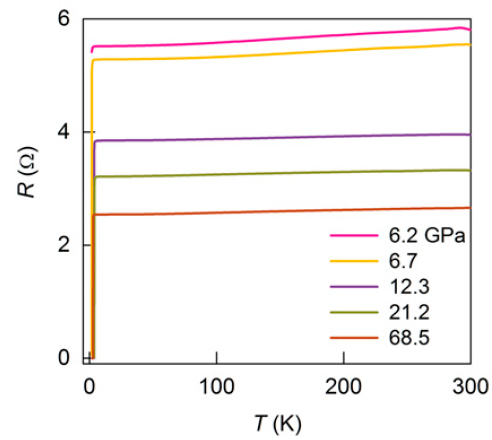Superconductivity in ZrTe5 under compression - Dr. Wenge Yang & Dave Mao
MARCH 2, 2016
By multiple complementary methods, new work co-led by scientists from HPSTAR, Dr. Wenge Yang, and Dr. Dave Mao, are trying to investigate possible crystal structural as well as electronic transitions in 3D topological material ZrTe5 under compression. Two pressure induced superconducting phases are found in ZrTe5. And in situ high-pressure synchrotron X-ray diffraction and Raman spectroscopy together with theoretical calculations indicate that the two-stage superconducting phases are correlated to two different crystal structural transitions at corresponding pressures.

Recent theoretical work proposed that single-layer ZrTe5 is a large gap quantum spin hall insulator, but the bulk one behaves between the strong and weak topological insulator. Also experimental study shows that ZrTe5 is a very promising system that hosts topological properties and might help to pave a new way for further experimental studies of topological phase transitions.
These discoveries spark the present team of scientists’ interests to further investigations on its Dirac and topological characters in ZrTe5 under high pressures as pressure has been proved to be an effective method for change electronic properties of energy materials by extensive studies.
Resistance and ac magnetic susceptibility measurements on ZrTe5 single crystal at various pressures up to 68.5 GPa, shows a superconducting transition at 1.8 K first noticed at 6.2 GPa. The superconducting transition temperature Tc increases with applied pressure, and reaches a maximum of 4.0 K at 14.6 GPa, followed by a slight drop but remaining almost constant value up to 68.5 GPa. At pressures above 21.2 GPa, a second superconducting phase with the maximum Tc of about 6.0 K appears and coexists with the original one to 68.5 GPa.
In situ high-pressure synchrotron X-ray diffraction and Raman spectroscopy combined with theoretical calculations are used to find possible explanation for the superconducting phases observed in ZrTe5. Both superconducting phases are confirmed to be consistent with a two-stage structural transition during the same pressure ranges, respectively.
This work is published on Early Edition PNAS entitled: “Pressure-induced superconductivity in athree-dimensional topological material ZrTe5”.
Caption: The emergence of pressure-induced superconducting transition at higher pressures ranging from 6.2 to 68.5 GPa.
The work is collaborated with High Magnetic Field Laboratory, Key Laboratory of Materials Physics, Institute of Solid State Physics, and Hefei Science Center, Chinese Academy of Sciences; National Laboratory of Solid State Microstructures, School of Physics, and Collaborative Innovation Center of Advanced Microstructures, Nanjing University; Geophysical Laboratory, Carnegie Institution of Washington. Other co-authors include Yonghui Zhou, Juefei Wu, Wei Ning, Nana Li, Yongping Du, Xuliang Chen, Ranran Zhang, Zhenhua Chi, Xuefei Wang, Xiangde Zhu, Pengchao Lu, Cheng Ji, Xiangang Wan, Zhaorong Yang, Jian Sun, Mingliang Tian, and Yuheng Zhang.
“This study again shows that high pressure is an effective, clean way to tune lattice as well as electronic states in topological insulators,” said Dr. Wenge Yang, a staff scientist from HPSTAR.
Paper in PDF.
